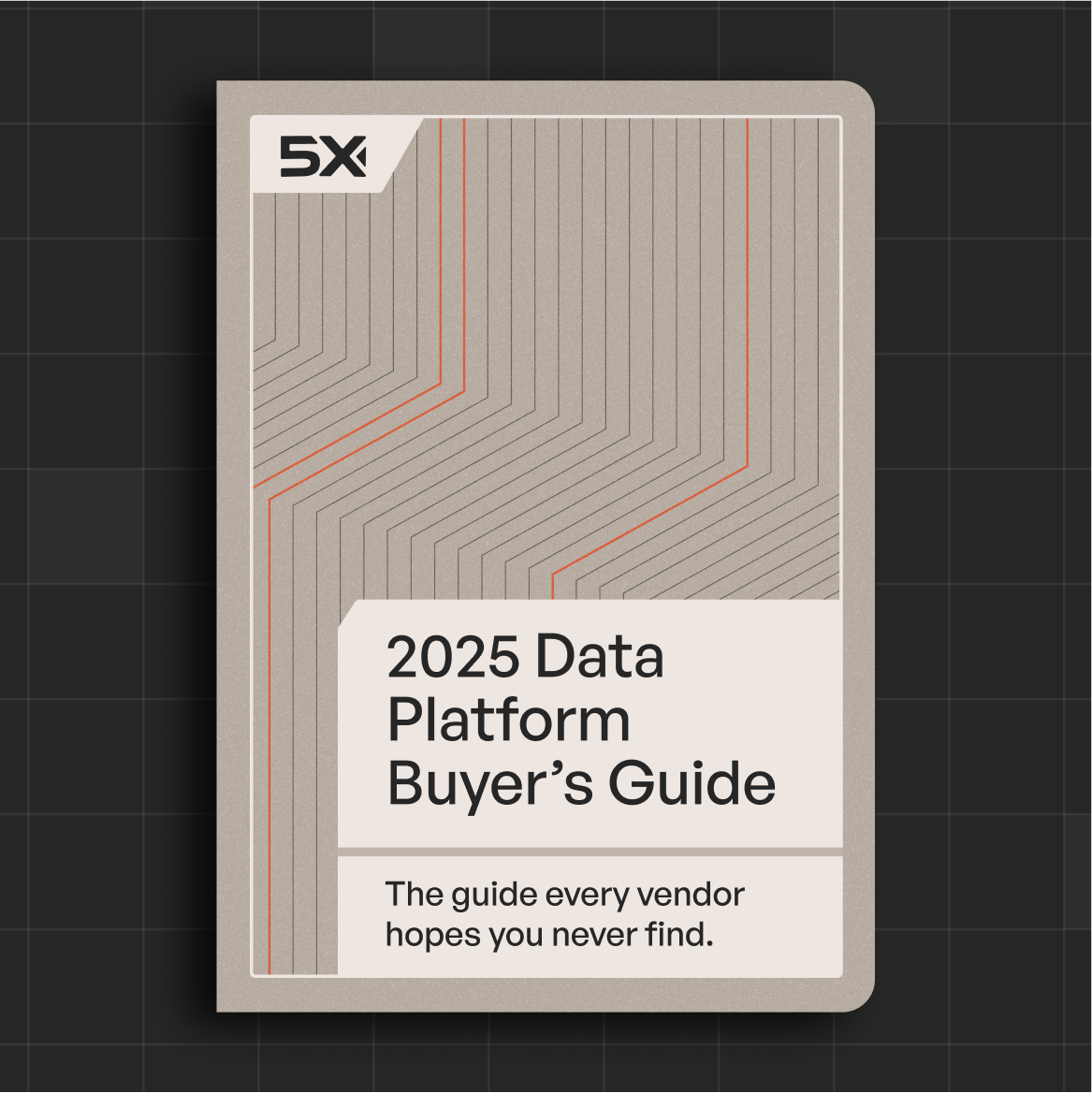Top 10 Data Lineage Tools in 2025: Complete Guide & Comparison

.png)
.png)
Table of Contents
TL; DR
- Data lineage is the backbone of trust in analytics. It shows exactly how data moves from source to dashboard, helping teams debug faster, stay compliant, and make confident decisions
- Look for automation, granularity, and integration. The best tools provide column-level lineage, impact analysis, and native connections across your data stack
- Top tools by feature set: 5X (end-to-end), Collibra (governance), Alation (collaboration), Atlan (modern UX), Informatica (hybrid enterprise), MANTA (deep code parsing), OpenLineage (open standard), OpenMetadata (open-source catalog), Talend (integration-focused), and Secoda (lightweight UX)
- Top tools by pricing: OpenLineage and OpenMetadata (free), Secoda and Talend (affordable SaaS), Atlan and Alation (mid-tier enterprise), Collibra, Informatica, and MANTA (premium), with 5X offering modular enterprise lineage built in
- Unlike standalone lineage tools, 5X captures lineage natively across ingestion, transformation, governance, and BI—giving you end-to-end visibility, zero setup, and full auditability from day one
If you’ve tried evaluating data lineage tools lately, you know the problem isn’t a lack of options; it’s the opposite. Every vendor claims to “do lineage,” but what that actually means varies wildly. Some only map SQL dependencies. Others visualize pipelines beautifully but stop at the warehouse. A few offer true end-to-end visibility—but only if you rebuild your stack around them.
Choosing the right tool has become a full-time job. Reddit threads are full of frustrated engineers comparing half-baked visual graphs, limited connectors, and opaque pricing.
So how do you tell substance from marketing?
In this post, we break down which features in data lineage tools actually matter and how the top tools stack up based on user feedback, independent reviews, and enterprise use cases.
9 Features to look for in data lineage tools
Choosing a data lineage tool is about ensuring the solution fits your stack and addresses your pain points. Modern data lineage tools go beyond basic traceability to offer automation, collaboration, and even AI-driven insights.
Here are the must-have features to consider:
1. Automated lineage discovery
Manual lineage documentation is virtually impossible at scale. Look for tools that auto-scan your databases, pipelines, and BI tools to infer lineage.
Automation ensures the lineage graph stays up-to-date as your data changes, without requiring constant human maintenance.
2. Granular, column-level lineage
High-level table-to-table lineage is helpful, but modern teams often need to trace issues at the finest grain. Column-level lineage shows how individual fields are derived and used.
This granularity is invaluable when, say, a specific metric is miscomputed, you can follow that single column through all its transformations.
3. Visual and interactive lineage graphs
Data lineage should be intuitive to explore. The best tools provide interactive flowcharts or DAGs where you can click on an asset (table, dashboard, etc.) and see its upstream sources and downstream dependencies.
4. Impact analysis and real-time alerts
A powerful lineage tool helps you anticipate and respond to changes. Predictive impact analysis lets you simulate a change (like modifying a transformation or deprecating a field) and see what downstream objects would be affected.
5. Comprehensive metadata and audit trails
Lineage is closely tied to metadata management. The tool should maintain a central repository of metadata about each data asset—who created it, when it was last updated, data definitions, quality stats, etc.
This context enriches the lineage view (so you see not just that “Table A flows to Table B” but also ownership, descriptions, and quality metrics).
6. Seamless integrations with your stack
Ensure the lineage solution connects with all the major tools in your data ecosystem. This includes databases/data lakes (e.g. Snowflake, BigQuery, Databricks), ETL/ELT and data orchestration tools (e.g. Fivetran, Airflow, dbt), analytics and BI tools (Tableau, Looker, PowerBI), and any data catalogs or governance systems you use.
7. Collaboration and ease of use
Since lineage will be used by data engineers, analysts, sometimes even business users, the tool should support collaboration features. This might include the ability to add annotations or comments on lineage graphs, share lineage views with teammates, or integrate with communication tools (like Slack alerts when lineage changes).
8. Governance and security features
Because lineage touches sensitive data assets, consider how the tool handles access control and privacy. It should integrate with your authentication (e.g. SSO) and allow role-based permissions, for instance, maybe only data stewards can edit lineage, while analysts can view it.
Some tools also offer PII tagging and propagation, meaning if a dataset is tagged as sensitive, that tag carries along in the lineage views so you know downstream if a report includes that PII data.
9. Built-in data quality and observability
While not a strict requirement, many teams find value in lineage integrated with data quality monitoring. For example, if a data quality tool detects an anomaly in Table A, lineage can immediately show what downstream tables or dashboards might be affected by that bad data.
Also read: 7 Data Quality Metrics Your Business Needs to Track
Top 10 data lineage tools in 2025
Many tools advertise “data lineage” capabilities, but they vary widely in approach and depth. Some are standalone lineage solutions; others bundle lineage into broader platforms (like data catalogs or observability tools).
Let’s review the top lineage tools of 2025, including both commercial products and notable open-source projects.
1. 5X: End-to-end platform with built-in lineage
5X is an all-in-one data platform encompassing data ingestion, orchestration and modeling, BI, semantic layer, and AI applications. Lineage is woven throughout the 5X platform as a core feature rather than an add-on.
Standout features
- Automatic lineage at every hop (ingest → transform → dashboard)
- Visual graph in the 5X console; click any asset to see upstream/downstream
- Ties lineage to data quality and job health; alerts appear on the graph
- Built on open standards (e.g., OpenLineage) to avoid lock-in
- Modular: adopt end-to-end or layer 5X lineage/governance on Snowflake, Databricks, BigQuery.
Best for
- Teams that want one control plane instead of stitching five tools
- Companies that need lineage plus governance, observability, and security
Ideal use cases
- Compliance and audit (GDPR, HIPAA) needing provable data trails.
- Impact analysis before schema changes or model releases.
- Incident response that spans ELT, semantic layer, and BI.
Unique advantages
- No extra setup for lineage; it’s captured by default.
- Zero blind spots because 5X powers the stages where lineage is lost in point tools
- Natural-language assistant to answer “what breaks if I change column X?”
G2 rating
Pricing
Managed platform; custom based on scale and modules. Private cloud and on-prem options. Visit Pricing | 5X for more info.
2. Collibra: Governance-focused lineage for enterprises
Collibra is well-known as a leader in data catalog and governance platforms. Collibra’s lineage capability is designed with governance in mind: Collibra not only shows lineage maps, but also enforces workflows, data ownership, and policies around your data assets.
Standout features
- Automated lineage across databases, ETL, and BI tied into the catalog
- Technical lineage (including column mappings) and business-friendly views
- Workflow-driven governance: approvals, owner notifications, and policy checks
- Impact analysis reports by asset and stakeholder
Best for
- Highly regulated enterprises (financial services, healthcare, insurance)
- Organizations with formal data governance and stewardship programs
Limitations
- Complex implementation; requires dedicated ownership and time
- Premium pricing; licensing tied to users/modules
- UI can feel heavy for smaller, agile teams
One reddit user said
G2 rating
Pricing
Custom, often six–seven figures annually for large deployments. Visit here.
3. Alation: Collaboration-centric data catalog with lineage
Alation is a leading data catalog that emphasizes ease of use and collaboration. Alation combines a searchable catalog with built-in data lineage and behavioral intelligence (it tracks how users query and use data).
Alation’s lineage feature is known for being intuitive and for bridging the gap between technical and business users.
Standout features
- Auto-lineage from SQL logs across warehouses and BI
- “Business lineage” views non-technical users understand
- Search that feels familiar, plus annotations, trust flags, and SME discovery
Best for
- Teams prioritizing self-service and data literacy
- SQL-heavy environments
Limitations
- Can miss non-SQL transformations or complex ETL logic
- Primarily read-only lineage; custom links require APIs
- Governance depth trails Collibra for some enterprises
G2 rating
Pricing
Enterprise subscription; priced by users/connectors. Visit Alation Pricing.
4. Atlan: Modern data workspace rethinking lineage
Atlan brands itself as a “democratized data workspace.” It’s a newer player blending data cataloging, lineage, and collaboration. Lineage in Atlan is a core feature that’s tightly integrated with its other capabilities like a business glossary and query workspace.
Standout features
- Table and column-level lineage; toggle business vs technical views
- Freshness and quality overlays, owner suggestions, Slack workflows
- Versioned lineage and OpenLineage support; ML lineage for model governance
Best for
- Modern cloud stacks (Snowflake/BigQuery + dbt + Airflow)
- Teams wanting fast time-to-value and clean UX
Limitations
- Legacy and on-prem coverage can require custom work
- Costs scale with assets and seats
G2 rating
Pricing
Tiered plans from growth to enterprise. Visit their contact page.
5. Informatica Metadata Manager: Lineage for complex, hybrid environments
Informatica is a veteran in the data integration space. Informatica’s Enterprise Data Catalog (EDC) and specifically its Metadata Manager component have offered data lineage for years, especially in traditional enterprises. If your stack involves a lot of Informatica tools (PowerCenter, etc.) or you have a mix of on-prem and cloud systems, Informatica’s lineage tool is built to handle that scale.
Standout features
- Harvests lineage across databases, ETL, BI, models, even Excel
- Logical + physical lineage, historical diffs, impact analysis
- Tight ties to data quality and MDM
Best for
- Banks, healthcare, and global enterprises with deep legacy plus cloud
- Programs that already use Informatica tools
Limitations
- Heavy setup and maintenance; UI feels older
- Premium pricing; adoption often centralized to data teams
G2 rating
3.4 / 5
Pricing
Enterprise licenses; often six figures+ annually. Visit Informatica pricing.
6. MANTA: Specialized lineage for complex data pipelines
MANTA is a vendor focused purely on automated data lineage. It originated as a tool to analyze SQL code and ETL logic to produce lineage maps. Now known simply as MANTA, it positions itself as providing deep, code-level lineage that’s plug-and-play with many environments.
In 2023-2024, MANTA gained attention for its ability to parse things like stored procedures, script files, and complex SQL to extract lineage where other tools struggled.
Standout features
- Detailed column-level lineage even through complex transforms
- Rich impact analysis; feeds Collibra/Alation/Informatica
- Scheduler to keep lineage current with deploys
Best for
- Engineering-led teams with thousands of ETL jobs
- Migrations and impact analysis across legacy codebases
Limitations
- Technical UI; less business-friendly
- Setup and tuning required; cost reflects niche power
G2 rating
Pricing
Enterprise pricing; scales with systems and complexity.
7. OpenLineage (and Marquez): Open-source standard for lineage
OpenLineage is an open-source standard and ecosystem for data lineage. It was initiated by contributors from WeWork (who built Marquez) and others, and is now part of the Linux Foundation’s data projects.
Marquez is the reference implementation (also open-source) that uses OpenLineage to collect and visualize lineage metadata.
Standout features
- Airflow/dbt/Spark emitters; job/dataset/run model
- Run-level context for observability; API-first; evolving column-level
- Linux Foundation backing and growing ecosystem
Best for
- Platform teams building internal stacks who want vendor-neutral lineage
- Orgs standardizing lineage in CI/CD
One Reddit user said
Limitations
- You own deployment, scaling, and UX for business users
- Not as feature-rich as commercial tools out-of-the-box
Pricing
Free to use; infra + engineering time required.
8. OpenMetadata: Open-source data catalog with built-in lineage
OpenMetadata is an open-source metadata management platform (essentially an open-source alternative to catalogs like Alation/Collibra). It comes with a user interface, supports connectors to various systems, and one of its core features is automated data lineage.
OpenMetadata can be thought of as the “app” on top of OpenLineage (among other things), as it integrates with OpenLineage but also has its own lineage capabilities.
Standout features
- Column-level lineage, no-code lineage editor, graph filtering
- dbt/BI native ties; Slack notifications; profiles and tags
- Can ingest OpenLineage events and parse SQL where needed
Best for
- Startups and engineering-driven teams preferring OSS
- dbt-centric analytics engineering workflows
Limitations
- Self-host and maintain; frequent upgrades
- Performance tuning needed at very large scale
Pricing
Free; paid hosting/support available from vendors.
9. Talend Data Catalog: Lineage within an integration suite
Talend, known for its ETL and data integration tools, also provides a Data Catalog that includes lineage. This is similar in spirit to Informatica’s approach: a vendor with integration background offering a catalog to track and manage metadata across sources.
Talend’s catalog can harvest metadata from databases, Talend jobs, and other sources to build a lineage picture, often with a focus on data governance and glossary as well.
Standout features
- Automated lineage + impact analysis across systems
- Business glossary integrated with lineage; ML-assisted classification
- Imports metadata from other catalogs (e.g., Atlas)
Best for
- Mid-market teams already using Talend
- Programs starting formal governance and glossary work
Limitations
- UI less modern; fewer AI features
- Connector breadth lags for some newer tools
G2 rating
Pricing
Typically bundled in Talend platform subscriptions; mid-market friendly. Visit Qlik Talend Cloud Plans and Pricing.
10. Secoda: Lightweight, user-friendly lineage for modern teams
Secoda is a relatively new data catalog startup that focuses on simplicity and UX. It offers a cloud-based catalog with data discovery, documentation, and lineage features.
Secoda is tailored for small to mid-sized data teams or startups that want the benefits of a catalog and lineage without heavy implementation.
Standout features
- One-click impact analysis; schema change alerts
- ERDs integrated with lineage; AI Q&A over metadata
- Quality alerts overlaid on lineage
Best for
- Startups and lean data teams that need quick wins
- Analytics engineering (Snowflake/BigQuery + dbt + Looker/Tableau)
Limitations
- Fewer legacy connectors; less customizable for very large enterprises
- Depth won’t match MANTA for heavy code parsing
Pricing
SaaS tiers by users/assets; accessible for mid-market. Visit Plans and pricing - Secoda.
Lineage that drives trust, not tickets
Data lineage is the foundation for reliable analytics, regulatory confidence, and faster decisions. But most tools still leave you stitching partial maps together, juggling UIs, or paying enterprise premiums for features you barely use.
Platforms like 5X are changing that—embedding lineage directly into the data lifecycle. Every dataset, transformation, and dashboard is automatically tracked, audited, and visualized without adding another tool to manage. That’s lineage as infrastructure.
FAQs
What is the best data lineage tool?

What is data lineage in ETL?

What are the cons of using a data lineage tool?

Building a data platform doesn’t have to be hectic. Spending over four months and 20% dev time just to set up your data platform is ridiculous. Make 5X your data partner with faster setups, lower upfront costs, and 0% dev time. Let your data engineering team focus on actioning insights, not building infrastructure ;)
Book a free consultationHere are some next steps you can take:
- Want to see it in action? Request a free demo.
- Want more guidance on using Preset via 5X? Explore our Help Docs.
- Ready to consolidate your data pipeline? Chat with us now.

How retail leaders unlock hidden profits and 10% margins
Retailers are sitting on untapped profit opportunities—through pricing, inventory, and procurement. Find out how to uncover these hidden gains in our free webinar.
Save your spot






%201.svg)

.png)
.png)






